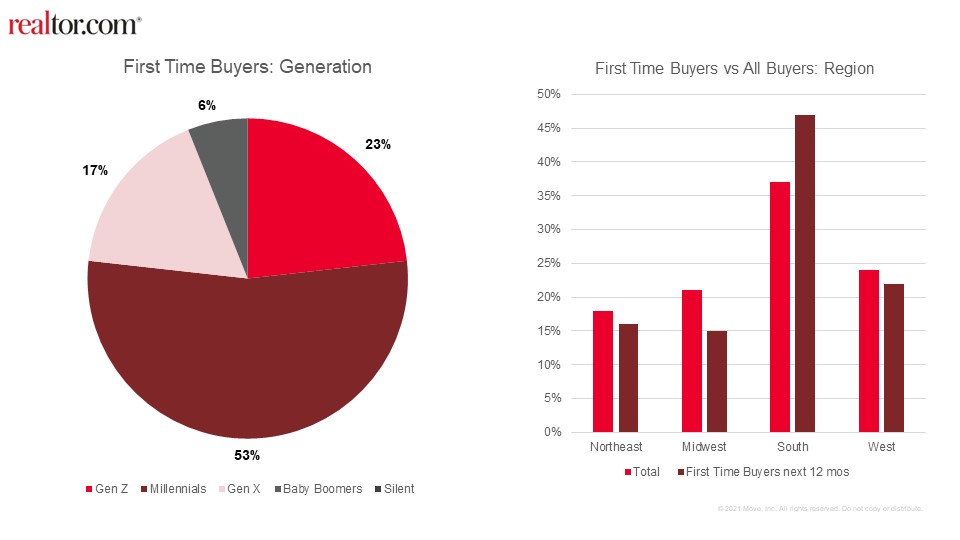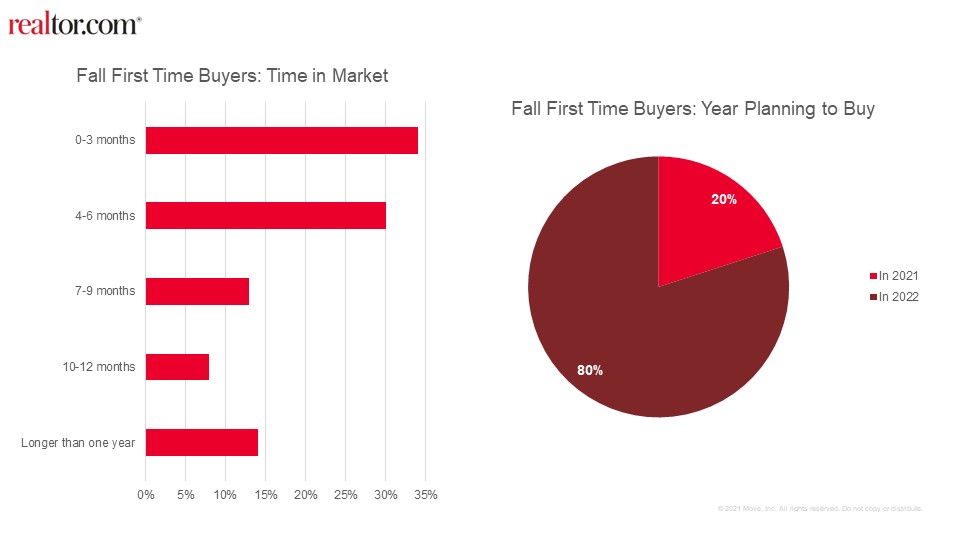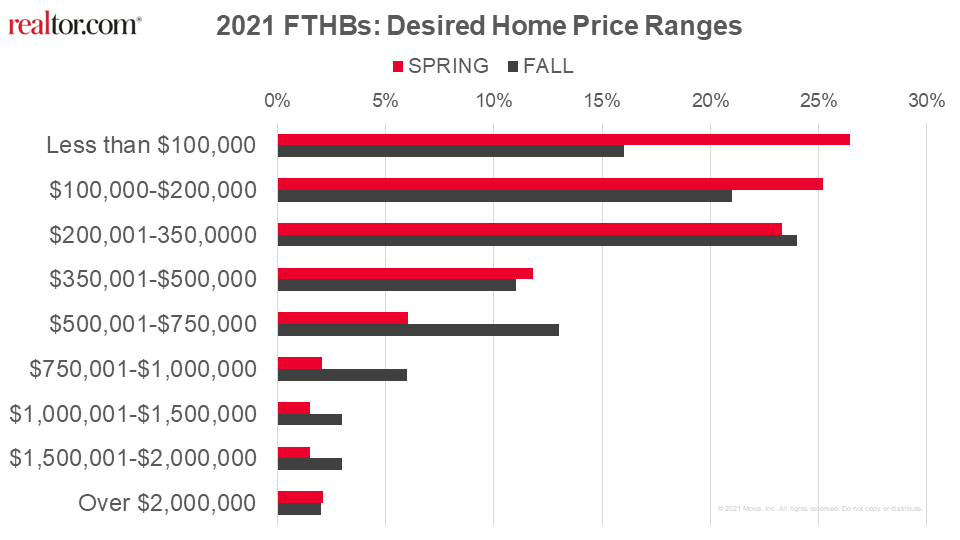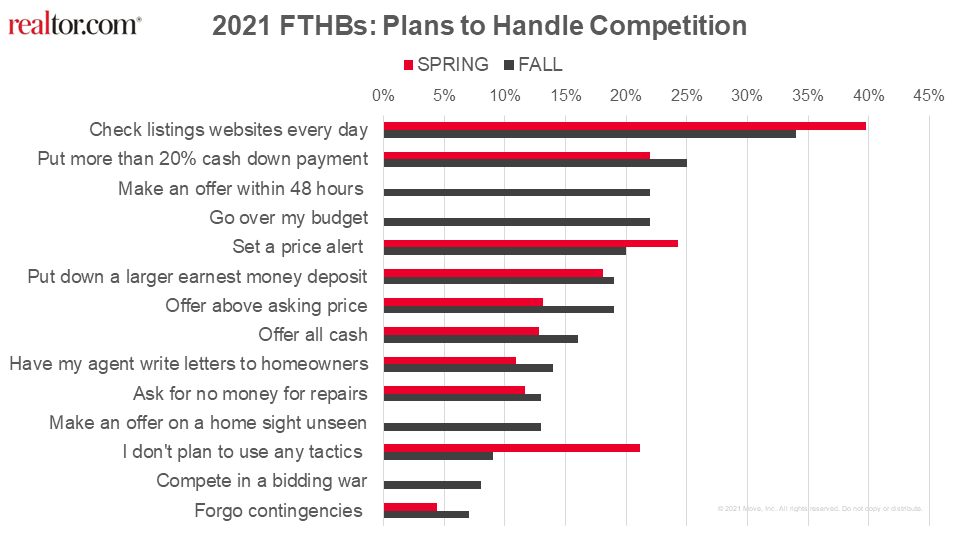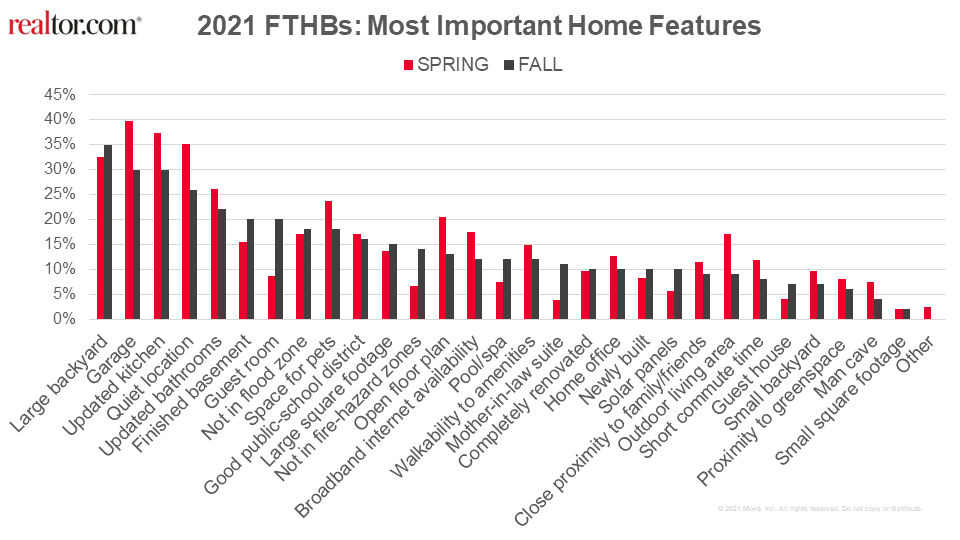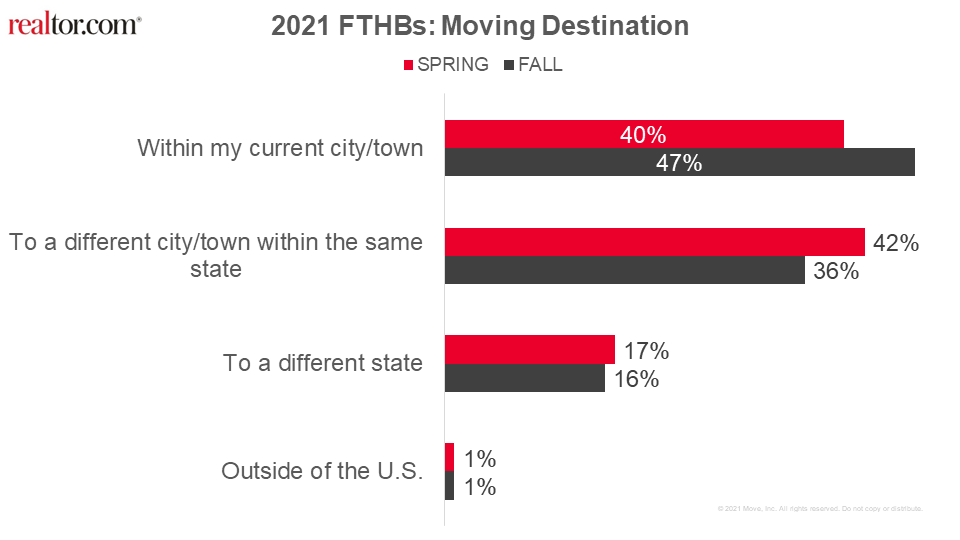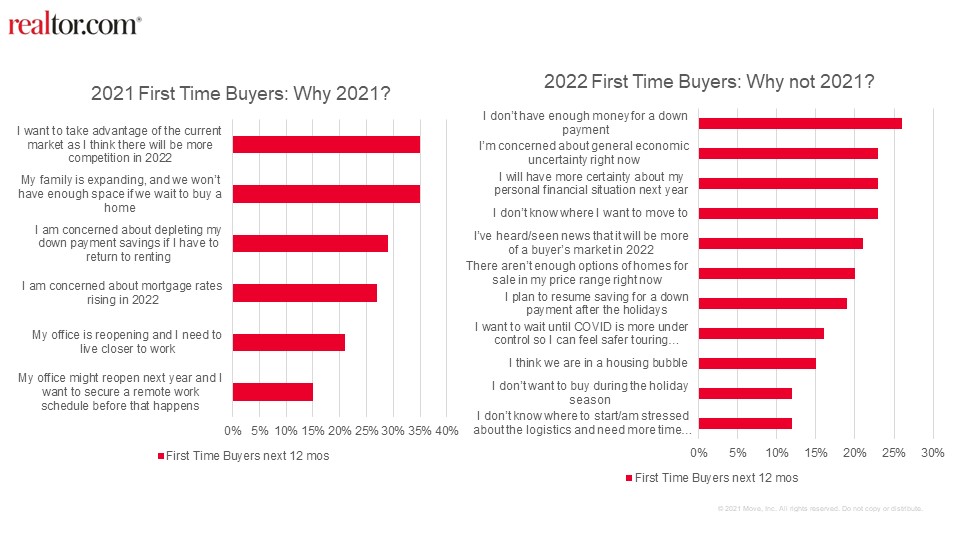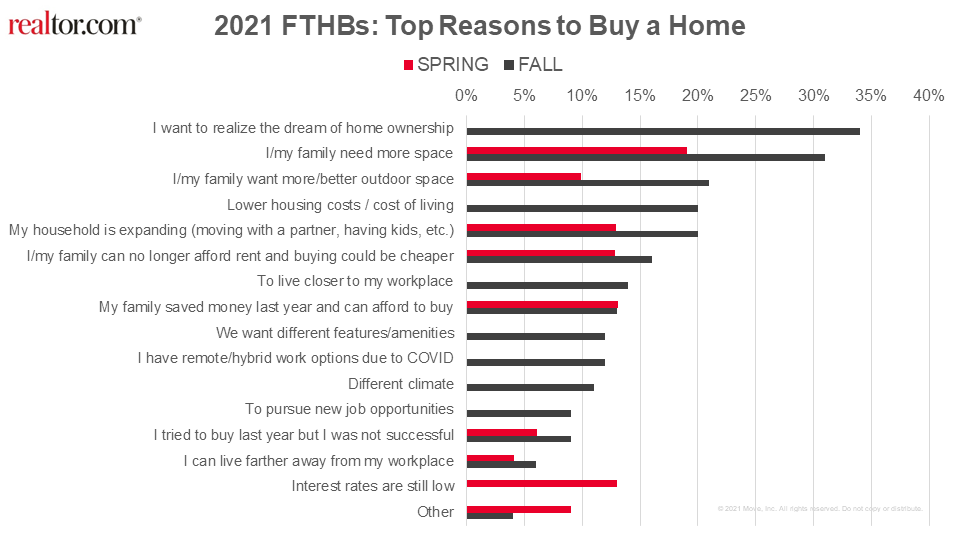First-time home buyers retain their optimism despite a challenging housing market in the past year. Hoping to achieve their goal of homeownership and provide a comfortable space for their families, young buyers are setting out to learn what they can about the market and setting their list of priorities for their home purchase. As the calendar approaches the new year, first time buyers can look forward to slightly better inventory, though competition will remain fierce. More than half of first time buyers are looking to move to a new city or state, which offers the opportunity to take advantage of lower-price markets.
76% of First-Time Homebuyers Are Gen Y & Gen Z
First time homebuyers tend to be younger than the total buyer population with 76% of first time homebuyers either in Gen Z or the Millennial generation. The total buyer population is mostly middle-aged or older with 26% in Gen X, and 31% Baby Boomers. First time homebuyers are concentrated in the South, with 47% of first time buyers purchasing in the southern region, compared to 37% of all buyers. About a third of first time homebuyers are each Hispanic, White and Black, while of all buyers, 63% are White, 16% are Hispanic, and 12% are Black.
72% of First-Time Buyers Aim to Buy in 2022
Most first time homebuyers (85%) are transitioning from paying rent to owning. As the 2021 housing market was difficult to break into, more than a quarter of first time homebuyers were unsuccessful at purchasing a home in 2021, compared to just 15% of all buyers. This challenging market resulted in 72% of first time buyers aiming to buy in 2022, though 20% still hope to buy in 2021. Most first time homebuyers (64%) have been in the housing market for less than 6 months, while non-first-time-homebuyers are more likely to have been in the market longer.
In order to get the buying process going, half of first time buyers have looked at listings online, 40% have researched home values in their target neighborhood, 34% have researched the real estate process, 30% have talked to friends/family for advice, and 25% have been in contact with a real estate agent. Interestingly, a larger portion (21%) of the total buyer population have been preapproved for a mortgage than of first time buyers (15%).
61% of First-Time Buyers Hope to Buy a Home Priced at or Below $350,000
First time homebuyers have a lower budget than all homebuyers, with 61% hoping to buy for less than $350,000, compared to 45% of all buyers. Only 8% of first time homebuyers are looking for a home over $1 Million, compared to 17% of all buyers. In general, first time buyers plan to put down less money as a down payment than the total pool of buyers, with 6% planning to put down 0% (using a VA loan), 19% plan to put down 3.5% (using an FHA loan) and 16% plan to put down 3.6% – 10%. For comparison, 41% of first time buyers plan to put down 10% or less, compared to just 26% of all buyers. However, on the flip side, 10% of first time buyers plan to offer all cash for a home, compared to 14% of all buyers. Most first time buyers acquired down payment money by saving a set amount each month (56%). Only 15% of first time buyers sold investments to acquire a downpayment compared to 27% of all buyers. Notably, 20% of all buyers and 18% of first time buyers received a gift from their family that will pay their downpayment.
As the year progressed, the imbalance between demand and supply conditioned market dynamics and pushed listing prices to record highs. The trends were mirrored in FTHBs price expectations. Whereas in the spring 75% of FTHBs looked for homes priced at or below $350,000, the share dropped to 61% by fall. The most noticeable changes occurred in the mid-range of the market, for homes priced between $500,000 and $1,000,000. The shift points to several likely factors, including move-up buyers, investor activity, as well as buyers adjusting expectations during a changing market.
Three-Quarters of First-Time Buyers Are Willing to Go Over Budget
To achieve their dream home, first time buyers are taking action to get ahead of the competition. These actions include checking listings everyday (34% of first time buyers), putting more than 20% down (25% of first time buyers), making an offer within 48 hours of seeing the home (22%) and being willing to exceed their budget (22%). Importantly, first time buyers are less willing to forgo contingencies or compete in a bidding war than all buyers. About a quarter of first time buyers are not willing to go over their budget, but 18% are willing to go up to 5% over, 19% are willing to go 6%-10% over, and 21% are willing to go 11-20% over.
In a nod to the competitive nature of real estate markets in 2021, FTHBs adjusted their willingness to overpay from the spring period to the fall. While 39% of FTHBs indicated that they would not pay above asking for a home in the spring, the share dropped to 24% by the fall. With prices continuing to rise throughout the year, larger shares of FTHBs indicated they were willing to pay above asking, with 3% pushing above 30% over asking. On a median-priced home in October that would have translated to more than $110,000 above list price, a significant premium.
In terms of getting ahead of competitors in the market, FTHBs indicated a variety of approaches, from leveraging technology, to above-asking and all-cash offers. Interestingly, the share of FTHBs who were not planning to use any tactics to outbid competitors dropped from 21% in the spring to 9% in the fall.
First-Time Buyers Are Motivated by Homeownership
First time homebuyers are especially looking for a home with a garage (30%), updated kitchen (30%), and a large backyard (35%). First time buyers are largely motivated to buy by realizing the dream of homeownership (34%), achieving more space for family (31%), and by acquiring more/better outdoor space (20%). Almost half of first time buyers plan to just move to a new neighborhood, while a sizable 36% plan to move to a new city in their state, and 16% plan to move to a different state. These plans closely match all buyers’ plans.
This year saw and ebb and flow in business activity, with the various COVID variants driving changes and expectations including housing. For FTHBs, the top desired amenities remained fairly consistent, although there were notable shifts. Garages dominated the must-have list of FTHBs in the spring, but they took second place by the fall, when large backyards took the number one spot. The other must-haves on the spring and fall lists were updated kitchens, quiet location, updated bathrooms and finished basements.
Several items saw rising interest from FTHBs as the year progressed, with more notable ones being finished basements, guest rooms, and homes outside flood or fire zones. Larger shares of fall FTHBs also looked for in-law suites, new construction, solar panels, and a guest house. Several features lost ground for FTHBs during the year: space for pets, open floor plans, broadband internet availability, short commutes, and small backyards.
The pandemic caused changes in migration patterns, as many homebuyers moved out of high-density downtowns toward suburbs and smaller sized cities with lower density and more affordable housing. However, as we move toward 2022, it seems that FTHBs are changing their geographical focus. In the spring, the largest share of FTHBs were looking for homes in a different city within the same state. By fall, the largest share centered the home search on properties within the current city. Even the share of FTHBs looking across state line saw a slight reduction, a potential sign that most moves to other states may slow in 2022.
Expanding Family Size Drives Purchasing Activity
First time buyers planning to buy in 2021 hope to take advantage of the current market, to provide a home large enough for their expanding family and to avoid depleting their down payment savings by continuing to rent. Additionally, 2021 first time buyers are concerned about increasing interest rates in the future. First time buyers who will wait to buy until 2022 have chosen to wait in order to save more money for a downpayment, as well as due to concerns over both general and personal economic uncertainty. On the other hand, the total pool of buyers surveyed cited lack of options and COVID uncertainty as their main reasons for holding off in 2021.
There were a few changes in priorities and preferences between the spring and fall periods for many first-time buyers. While the dream of homeownership was the overriding theme for many FTHBs, demographic changes are leaving their mark. With millennials moving firmly into their 30s, and forming families, the need for more space increased as did expanding households. Furthermore, with families, larger shares of FTHBs sought different features in their homes, more access to the outdoors, and a lower cost of living.
Methodology:
The survey was conducted online from Sept 23 – Oct 1 among 2,583 adults by HarrisX (which includes an oversample of 502 respondents buying a house for the first time in the next year). The sampling margin of error of this poll is plus or minus 1.9 percentage points. The results reflect a nationally representative sample of U.S. adults. Results were weighted for age by gender, region, race/ethnicity, income, and the status of those first time homebuyers where necessary to align them with their actual proportions in the population.

